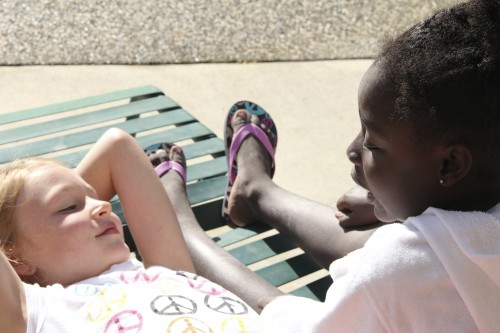
 Many of us struggle with both physical and emotional nakedness – with ourselves, with others and with life around us. Rather than embracing experiences or struggles, and letting them affect us, we brace ourselves, our close any experience off that would force us to feel exposed.
Many of us struggle with both physical and emotional nakedness – with ourselves, with others and with life around us. Rather than embracing experiences or struggles, and letting them affect us, we brace ourselves, our close any experience off that would force us to feel exposed.
If this is something you struggle with, you’re in good company. Elizabeth Mattis-Namgyel, author of The Power of an Open Question: The Buddha’s Path to Freedom, writes of her own struggle with what she describes as, “letting life touch her” while she was studying Buddhadharma on retreat. She begins with her own rigidity. “Having spent many years in a retreat setting I have observed that there is a tendency for people to fall into two kinds of mind-sets: practitioners either try to engage with others to distract themselves, or else they become very closed and rigid about their boundary,” she writes. “I was obviously one of the rigid ones.”
She continues on to recount her inner discomfort when her teacher forced her to leave retreat and enter a naked hot springs in order to lose her fear of interaction. After returning from her time away, she writes that she began to understand that bracing against our experiences and emotions to do with the life around us can do more than block off our emotion. It can block our breathing, our physical health and our freedom to experience.
I am not suggesting we walk around naked…or even become more socially engaged. I have great respect and love for retreat life and being alone. But I can see from having spent time in retreat that practice is not about isolating ourselves from the grandness, richness and poignancy of life.
Is it possible for us to find ways to better interact with the life around us, rather than bracing against it? Elisabeth explains that there is, within the teachings on bodhicitta, and their emphasis on extending loving kindness towards others:
Experience doesn’t happen in isolation, “inside” the parameters of the body. We are always in relationship with our world. All the information we take in through our senses affects our body, our energy, emotions and our conceptual mind. What we call “the world” and what we call “the body” are inextricably linked: not one and not two.
This is why the teachings on bodhicitta (that emphasize the practice of extending loving-kindness toward others) are so important. They move us out of our contracted state where we solely focus on cherishing and protecting our self, into the great nature of interdependence. So it is not that we have to get rid of the self at all. We just need to include others in the realm of care we usually reserve for ourselves.
So the purpose of bodhicitta is not solely to help others (although the longing to extend loving-kindness to others will naturally increase with the practice). The purpose of bodhicitta is also to increase our ability to include life in all its pain and glory. I say this because we often have as much resistance admitting pleasure into our life as we do pain.
So the practice here is to expand and include – to let life touch us. This is an emboldening experience that brings us into a balanced and sane relationship with our world.
Read more about letting life continue to touch you.
What are some ways you tend to brace against life, and some ways you can think differently about letting life touch you within that struggle?

